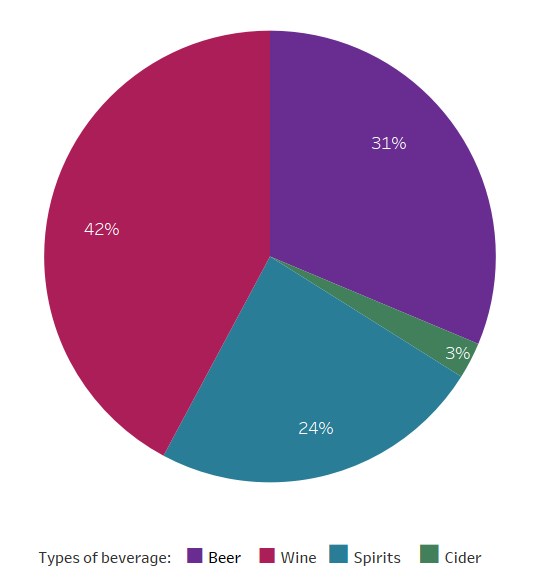Trends in alcohol available for consumption
This release adds new estimates for the volume of alcohol available for consumption from 2020–21 to 2022–23 (Figure 1).
Further details on new estimates and data sources are found in Technical notes.
Definition
Alcohol available for consumption (previously called ‘Apparent consumption of alcohol’) refers to the total amount of alcohol either produced in Australia or imported into Australia, that will be sold to people living in Australia.
The definition assumes that all alcohol that was produced or imported was made available in the same financial year. Per capita consumption refers to the Australian population aged 15 and over.
Pure alcohol is defined as the total amount of alcohol if it were isolated from all alcoholic beverages such as beer and wine.
No corrections are made for beverages that may have been wasted, used in cooking, cellared, or otherwise not consumed, and beverages that were purchased overseas and brought into the country duty-free are not included.
Figure 1: Alcohol available for consumption by beverage type, 1944–45 to 2022–23
Since 2014–15, wine has contributed more to total alcohol available for consumption than any other beverage type.

Downloadable data tables are available on Data.
Changes in the total amount of alcohol available for consumption
In 2022–23, there were 225.4 million litres of pure alcohol available for consumption in Australia, an 8.1% increase from 208.6 million litres in 2019–20. The amount of alcohol available for consumption per capita also increased, from 10.0 litres in 2019–20 to 10.5 litres in 2022–23 (Figure 1). This increase is equivalent to about 4 bottles of red wine per person in Australia over the course of a year.
The amount of alcohol available for consumption in Australia decreased slightly from 10.3 litres per capita in 2018–19 to 10.0 litres in 2019–20 but increased sharply to 10.9 litres in 2020–21. This marked the highest year-on-year increase since the collection began in 1960–61. The increase in the amount of alcohol available for consumption between 2019–20 and 2020–21 was also seen in higher spending on online liquor retailing during the COVID-19 pandemic (AIHW 2024). Per capita alcohol availability remained high in 2021–22 and 2022–23 despite slight decreases in per capita consumption.
Recent trends in alcohol available for consumption were different for different beverage types, as shown in Figure 2.
Figure 2: Litres of pure alcohol available per capita by beverage type over time

Source: AIHW 2024. Alcohol available for consumption in Australia
Changes in the total amount of alcohol available for consumption
The largest change between 2019–20 and 2022–23 was a 22% increase in the amount of alcohol from spirits being made available for consumption, from 44.2 million litres to 53.8 million litres of pure alcohol. This increase continued the upward trend observed since 2016–17, when 35.4 million litres of pure alcohol from spirits were made available. Over the same time, the amount of alcohol from cider made available increased by 12%, wine increased by 9.6%, and beer decreased by 2.5%.
In 2022–23, wine still accounted for the largest proportion of pure alcohol available for consumption in Australia at 42%. It was followed by beer at 31%, spirits at 24%, and cider at 3% (Figure 3).
Figure 3: Breakdown of alcohol available for consumption in 2022–23 by beverage type

Source: AIHW 2024. Alcohol available for consumption in Australia
The historically large changes in the amount of alcohol made available between 2019–20 and 2020–21 (during periods of COVID-19 related health measures) were reflected by changes in the availability of all alcoholic beverage types, but to different degrees:
- Spirits increased by 17%, from 2.1 litres per capita to 2.5 litres per capita.
- Cider increased by 12%, from 0.25 litres per capita to 0.28 litres per capita.
- Per capita consumption of wine increased by 8.9%, from 4.1 litres to 4.6 litres.
- Beer only slightly increased from 3.49 litres per capita to 3.53 litres per capita.
Australian Institute of Health and Welfare (2024) Alcohol, tobacco & other drugs in Australia, AIHW, Australian Government, accessed 10 October 2024.


